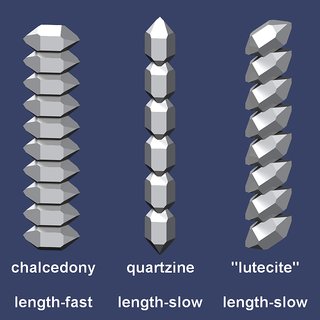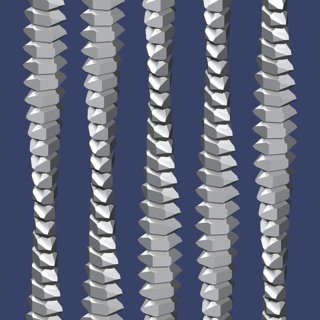last modified: Friday, 04-Nov-2011 13:41:09 CET
Document status: incomplete
"Quartz" is a term that includes both well crystallized and compact forms of silica. For the most time the different quartz varieties have been considered as species of their own and have not been systematically grouped together before the 19th century. Their common chemical nature was discovered by the Swedish chemist Bergmann at the end of the 18th century, and for some time silica was considered a chemical element. In 1823 his fellow countryman J.J. Berzelius decomposed quartz and discovered it is the chemical compound of oxygen and a new element, silicon. After it was realized that all those varieties are chemically the same substance, silicon dioxide, SiO2, they were divided into groups.
Old Classification Scheme
For a long time the classification was mostly based on the visual appearance and the possibility to resolve structural elements in an optical microscope:-
Macrocrystalline Quartz
Varieties that develop visible crystals or are made of large intergrown crystals
(macro - large)
- Microcrystalline Quartz
Compact varieties made of tiny crystal grains that are visible in an optical microscope
(micro - small)
-
Cryptocrystalline Quartz
Dense varieties whose structure cannot be resolved in an optical microscope
(crypto - hidden)
Some authors have used different names for the three groups, for example compact quartz instead of microcrystalline quartz, and (more confusing) microcrystalline quartz instead of cryptocrystalline quartz, but the members of the groups were usually the same. The following table is an overview of this "old" classification scheme.
| Old Classification Scheme for Quartz | ||
| Macrocrystalline Quartz | Microcrystalline Quartz | Cryptocrystalline Quartz |
|---|---|---|
|
Ideal Type: |
Ideal Type: |
Ideal Type: |
In this scheme, rock crystal is the ideal of macrocrystalline quartz and, with the exception of aventurine and tiger's eye, all other variants can be regarded as derivatives of it. The ideal type of cryptocrystalline quartz is chalcedony, with agate and chrysoprase being variants. Jasper can be viewed as ideal image of microcrystalline quartz, but chert and flint would not be considered variants of jasper, so there is a first inconsistency in this scheme.
This scheme suggests that there are gradual transitions from one group to the other, and this is, for example, reflected in the fact that aventurine and tiger's eye have been classified both as macro- and (erroneously) as cryptocrystalline (that's why they appear twice in the table).
Modern Classification Scheme
Today, most authors use a different scheme for classification. The crystalline forms are commonly called macrocrystalline quartz, while the dense and compact forms are either called cryptocrystalline or microcrystalline quartz (sometimes authors distinguish between megaquartz and microquartz, but the term "microquartz" is also used to name a specific granular texture of cryptocrystalline quartz).When people talk about "quartz", they often mean macrocrystalline quartz, whereas cryptocrystalline varieties are often subsumed under the term chalcedony.
The following table is an overview of the "modern" classification scheme, and lists all varieties that have been given their own chapter on this website.
| Modern Classification Scheme for Quartz | ||
| Macrocrystalline Quartz or simply "Quartz" |
Crypto- or Microcrystalline Quartz or simply "Chalcedony" |
|
|---|---|---|
|
Ideal Type:
|
Ideal Type: "Fibrous" Varieties: "Grainy" Varieties: |
|
The distinction between "fibrous" and "grainy" varieties is based on the visual appearence of thin sections in a polarizing microscope.
It has been found that the causes for the differences in structure, physical properties and visual appearance lie primarily in the environmental conditions during the formation of the minerals:
Macro- and cryptocrystalline forms of quartz differ in the way they grow.
- Macrocrystalline quartz grows by adding molecules to the crystal's surface, layer by layer.
- Cryptocrystalline quartz forms from a colloidal watery solution of silica
It should be noted that this is still an oversimplification and that there are cases that do not fit well in that classification scheme, in particular the formation of certain rocks made of chert and certain rocks made of a silica sinter. The first sometimes forms from opaline sediments or glassy volcanic ashes, the latter is observed in low and medium temperature, low pressure veins, and in geysers, often together with opaline sinter. Both assume a cryptocrystalline structure (similar in look to flint and jasper) but do not form from gel-like colloidal precursors. The formation of the "grainy varieties" like jasper and flint and their respective subvarieties also seems to deviate in some ways from that of "ordinary" fibrous chalcedony.
The specific properties of macro- and cryptocrystalline quartz are simply a consequence of the way they form. The growth mechanisms and environmental factors of both quartz types are thoroughly discussed in the chapter Formation and Growth. The most important properties are listed for comparison in the following table.
| Macrocrystalline | Cryptocrystalline | |
|---|---|---|
| Color | any | any |
| Diapheny | transparent-translucent | translucent-opaque |
| Luster | vitreous | waxy - dull |
| Luster on Fractures | vitreous - fatty | dull |
| Streak | white | white, slightly colored |
| Refractive Index | 1.54422-1.55332 | 1.53-1.54 |
| Specific Weight | 2.6481 g/cm3 | 2.4-2.7 g/cm3 |
| Hardness | 7 | 6.5-7 |
| Water Content | << 0.1% | 0.1-4% |
| Non-Silica Impurities | 0.01% - 0.5% | 1% - 20% |
One notable difference is that the numerical values for refractive index, specific weight, and hardness of macrocrystalline quartz are exact, while the values given for cryptocrystalline quartz are approximations .
The reason is that cryptocrystalline quartz varieties mostly consist of microscopically small intergrown quartz crystal grains, so they lack the structural homogeneity of crystals. Their final structure varies with the environmental conditions and also depends on the amount of impurities that have been embedded during formation. Strictly spoken, cryptocrystalline varieties don't count as minerals, they are so-called textural varieties of quartz, and more similar to rocks (like marble or quartzite). They contain relatively large amounts of other silica modifications, water and other non-silica minerals.
The mineralogy of macrocrystalline quartz, on the other hand, is fairly straightforward, and if it wasn't for its abundance and its important role in many different geological environments, there would not be so much to say about it. One notable mineralogical property of quartz is that clear crystals, even those of colored varieties, are remarkably pure, as explained in the chapter Chemical Properties.
Cryptocrystalline Quartz
Within the cryptocrystalline varieties there is a line drawn between so called fibrous and grainy varieties. These subgroups roughly correspond to the micro- and cryptocrystalline groups of the old classification.The naming for these subgroups is a bit misleading. In scanning electron microscopic studies it has been shown that both are actually grainy and consist mostly of microscopically small intergrown crystal grains (e.g. Monroe, 1964). The term "fibrous" is based on observations in polarization microscopes. Thin sections of chalcedony display a peculiar striated pattern under polarized light that leads to the impression of a fibrous structure. The reason is that the crystallographic axes of the individual grains lie roughly parallel to each other, so the grains are stacked in a specific manner. Quartz is birefringent, and the amount of polarized light that passes through a crystal depends on its orientation. Since the orientation of subsequent grains in a stack changes more or less gradually, a wave-like to zigzag-like pattern emerges, the so-called Runzelbänderung ("wrinkle-banding"), a term coined by Bernauer, 1927.
Apparently the first that systematically described the patterns they observed in a polarization microscope were Michel-Lévy and Munier-Chalmas in 1892 (from Graetsch, 1994). They described three types of "fibers", distinguished by their optical properties:
- Chalcedony - "length-fast chalcedony"
- Quartzine - "length-slow chalcedony"
- Lutecite - "length-slow chalcedony"

|
Note: It should be stressed that this figure only depicts the relative crystallographic orientation of quartz grains; it is not a realistic representation of the structure. The grains are tightly intergrown and do not generally look like ideal quartz crystals. There are no real, isolated and separable fibers, and thus I will call them virtual fibers.
In length-fast chalcedony the grains appear to be stacked perpendicular to the c-axis, and along an a-axis (virtual fiber axis either <1120> or <1010>). The preferred growth direction seems to be along <1120> (Braitsch, 1957).
In quartzine the grains are stacked along the c-axis (virtual fiber axis [0001]), with the a-axes of neighboring grains being roughly parallel, which is more like the behavior that one would expect from quartz.
Lutecite was the name for fibers that appeared to be made of quartz grains that are stacked parallel to their rhombohedral r faces. It has recently been identified with the silica polymorph moganite, and the initial interpretation of the fibers' geometry reflects the structural relationship between moganite and quartz (Heaney and Post, 1992). In their nomenclature of microcrystalline silica minerals Flörke et. al, 1991, consider the term "lutecite" as obsolete.
The term pseudochalcedony was introduced by Lacroix, 1900, for virtual fibers that are similar to length-fast chalcedony, but show a different extinction pattern in a polarization microscope. X-ray texture analysis has recently revealed that these virtual fibers are apparently elongated perpendicular to {2021} (Cady et al., 1998).
In addition to these "fibrous" components many cryptocrystalline varieties contain microquartz, small, randomly intergrown grains of "ordinary" macrocrystalline quartz. Often these parts look milky and show a rough fracture surface.
For a detailed overview of the microstructure and properties of the various types of "fibrous" quartz see Braitsch 1957; Frondel 1978; Flörke et al. 1991; Graetsch 1994 and Cady et al. 1998.

|
The crystallographic orientation of the adjacent virtual fibers changes more or less gradually, as indicated in Fig.2. This is what causes the striated pattern and the overall fibrous appearance of a thin section seen in a polarzing microscope.
Polysynthetical Brazil law twinning on a microscopic scale is not only found in legth-fast chalcedony, but also in quartzine (length-slow chalcedony) as shown by Xu et al., 1998.
Thin sections of the grainy varieties jasper, flint and chert and their derivatives show an irregular, fine-grained pattern when viewed in a polarization microscope. This is due to a larger proportion of microquartz and due to the random orientation of the chalcedony "fibers". They also contain much larger amounts of impurities and are only slightly translucent to opaque. The granular structure has been confirmed in scanning electron microscopy studies of fracture surfaces (Monroe, 1964).
Initially it had been assumed that opal is an essential component of chalcedony (in particular of agate), and is intergrown with quartz grains (Correns and Nagelschmidt, 1933). This could not be generally verified in various x-ray diffraction studies (e.g. Heaney et al., 1994). Opal is occasionally associated with chalcedony, forming entire parts of a specimen, like the rim of an agate nodule. Opal and chalcedony also may occur together in maturing chert rocks and silica sinters (Lynne et al., 2007) which both develop from opaline silica.
Further Information, Literature, Links
Footnotes
 Printer Friendly Version
Printer Friendly VersionCopyright © 2005-2013, A.C. A k h a v a n
Impressum - Source: http://www.quartzpage.de/gen_types.html
